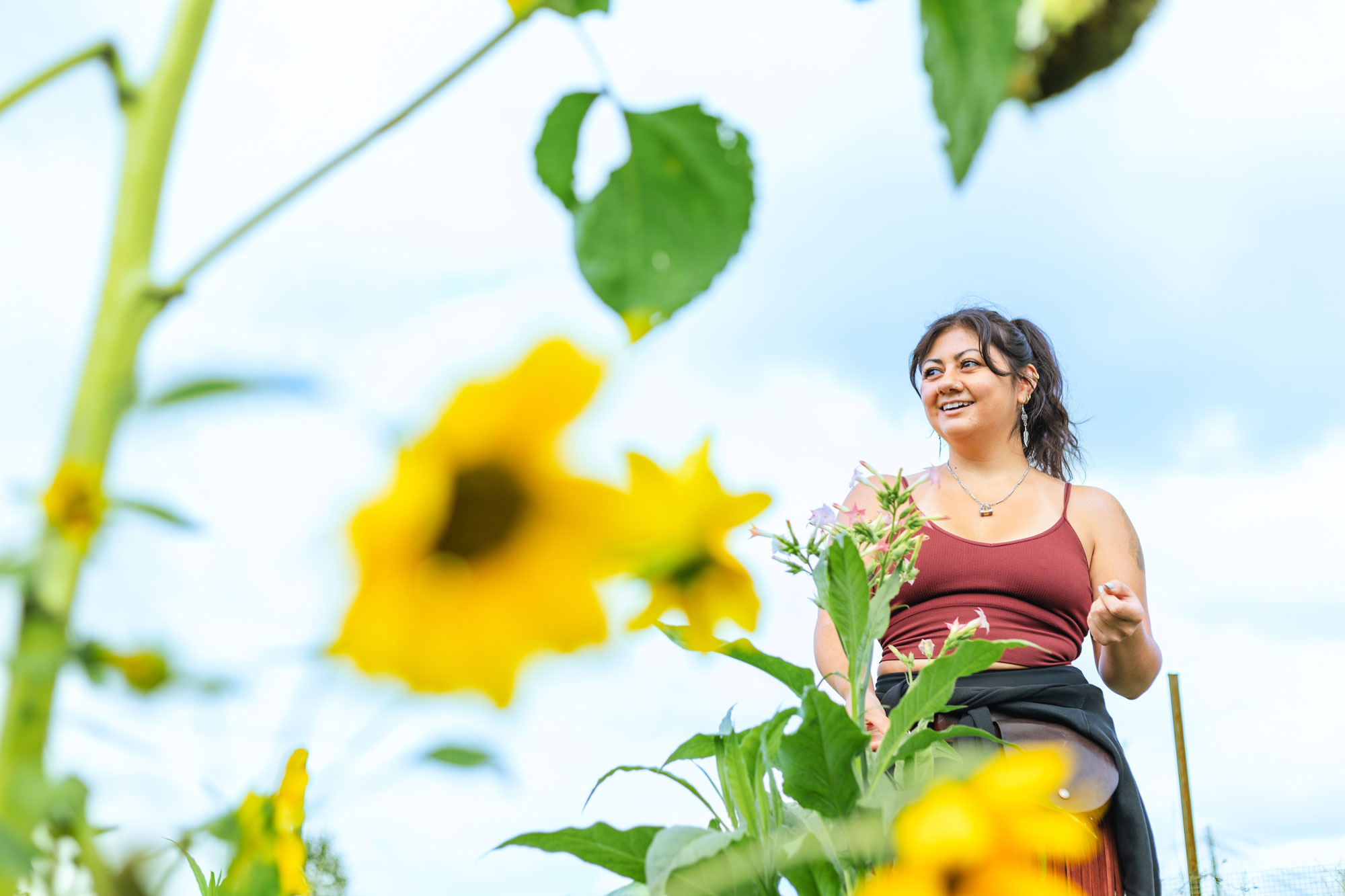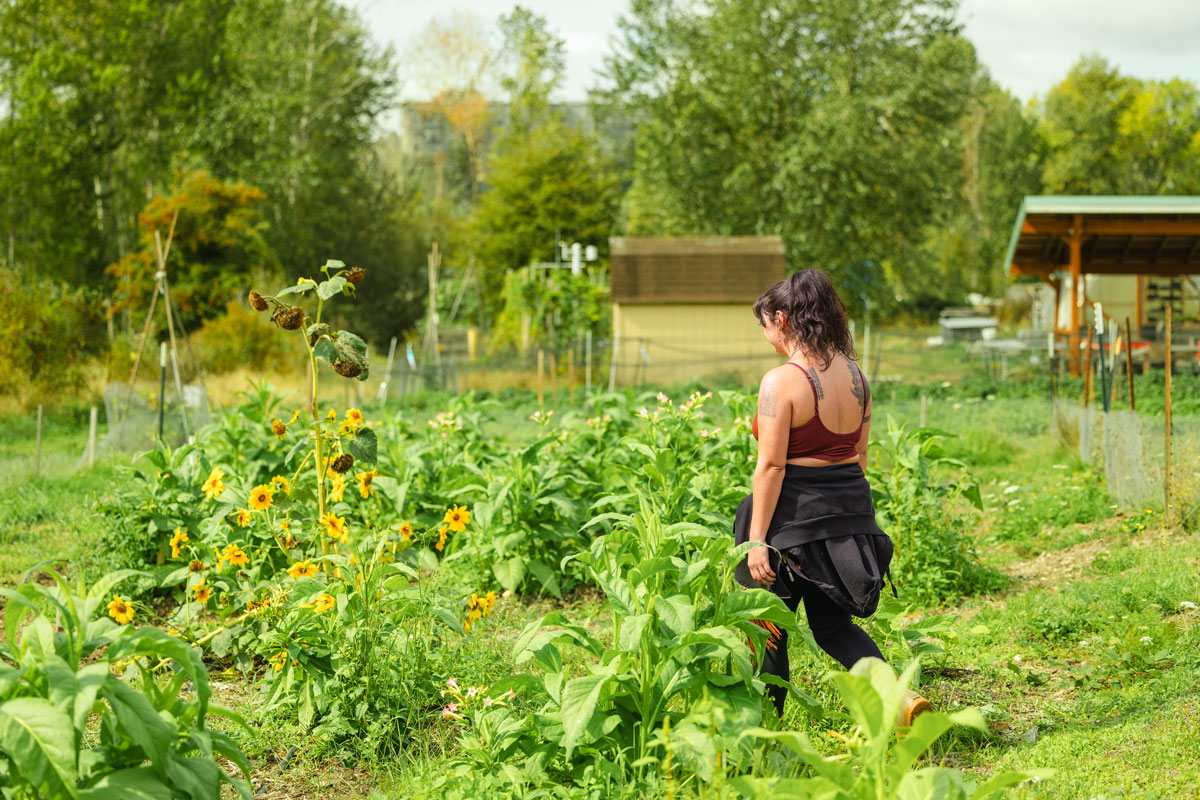Cultivating community Cultivating community Cultivating community
Years in the making, the Native Garden at the UW Farm highlights Indigenous food and farming practices.

Years in the making, the Native Garden at the UW Farm highlights Indigenous food and farming practices.
In 2018, at a picnic table overlooking the University of Washington Farm, the new farm manager, Perry Acworth, sat with Iisaaksiichaa Ross Braine (Apsaalooke Nation) as he laid out his idea for the Native Garden.
“He said, ‘There are First Nations @ UW students who are food insecure, and I want to solve this challenge,’” Acworth recalls. First Nations @ UW is an undergraduate intertribal registered student organization.
Creating the garden was outside Braine’s job description—director of wǝɫǝbʔaltxʷ – Intellectual House, a gathering space for Indigenous students, staff and faculty—but he felt a pull of responsibility. (wǝɫǝbʔaltxʷ is pronounced WESH-ehb-ALT.) “My culture mandates that I teach the next generation,” he says. “It’s an unbroken chain back to our traditions pre-contact.”
The idea for the garden was years in the making by the time Braine approached Acworth, but he needed her support to bring it to life. Acworth, who was once food insecure herself, didn’t need much convincing.
The two worked together to find a location, eventually settling on the UW Farm at the Center for Urban Horticulture. Upon arriving at the UW, Acworth had prioritized learning the history and culture of the Pacific Northwest—specifically the story of the land where she would be working. The site of the farm is culturally significant to Coast Salish peoples. Once home to longhouses and a fishing weir, it was industrialized by settlers in the late 1800s and later became a landfill for residential and industrial waste. The landfill closed in 1966 and was eventually repurposed. “The Native Garden is basically a way to ‘rematriate’ that area back to Indigenous peoples,” Acworth says. “Our goal is to honor, acknowledge and make space for the traditional peoples.”

Fourth year student Sarai Mayer (Washoe), the UW Farm’s food sovereignty liaison, weeds and tends plants in the Native Garden.
Starting in 2018, Braine, students and volunteers worked to create the garden, sweating through 90-degree afternoons and sometimes digging by hand. The project became what Braine had envisioned: a way to address Indigenous food insecurity, reintroduce Native foods, teach students a trade and support mental health. “There’s something right and good about being in the soil with your hands,” says Braine, now a UW doctoral student and tribal liaison in the Washington State Office of Equity. “This was a way for us to practice the traditional ways of our tribes and their ecological knowledge. It was a place for us to just be.”
The garden’s mission resonates with student Sarah “Sarai” Mayer, who was born to a Washoe father and a Thai mother. She is the food-sovereignty liaison for the Native Garden, a role funded by UW Farm and – Intellectual House. “We’re living culture,” Mayer says. “We’re doing a continuance of the work that our ancestors have done. We’re supporting each other, connecting with our different cultures and trying to make a space for that on campus.” After she graduates, Mayer plans to pursue a degree in botanical scientific illustration.
As the liaison, Mayer says her most important jobs are showing how to work with the land using traditional teachings and introducing the idea of food sovereignty. Professor of American Indian Studies Charlotte Coté (Tseshaht/Nuu-chah-nulth) describes Indigenous food sovereignty as “the right of peoples to eat healthy and culturally appropriate food and have that food harvested and processed through ecologically sound and sustainable methods.”
“This was a way for us to practice the traditional ways of our tribes and their ecological knowledge. It was a place for us to just be.”
Iisaaksiichaa Ross Braine
Coté is the co-founder and chair of The Living Breath of Indigenous Foods Symposium, a campus event the Native Garden often supports by providing produce. “Gardening teaches students not just about growing vegetables but also how important they are to certain Indigenous communities that have a very strong agricultural base,” she says. “You’re creating spaces that bring students—especially Native students—together. Having these kinds of spaces exemplifies the spirit of coming together and being in community.”
The garden started as a single 30-by-70-inch plot. Now there are 56 mounds. “We’re all trying to work together to make sure we ensure access,” Mayer says, “so the Native Garden is useful for the people who need it.” Among other crops, corn, beans and squash are grown using the traditional Three Sisters method. The crops support each other when planted together: Corn offers stalks for beans to climb, beans provide nitrogen to keep the soil healthy and shade from the squash helps the soil retain moisture and prevents weeds.
The latest developments in the garden include a pond for the cultivation of aquatic crops such as wapato, an edible tuber that once grew in abundance in Washington and Oregon wetlands. Mayer has recently focused on growing medicinal crops, like ceremonial tobacco, and would love to oversee the development of a separate medicinal garden.
The Native Garden also has a new mentor in Polly Olsen (Yakama Nation), ’94, tribal liaison and director of diversity, equity, access, inclusion and decolonization at the Burke Museum. She will lead students and other groups in farming, gardening and traditional food stories.
“To see the students’ pride—I did it all for that,” Braine says. “All the arguments, all the fundraising, all the digging and pulling. It was just so worth it to see that. And then when somebody was hungry—to see them come in, grab something and leave without any judgment. That’s what it was all about.”